Jetsonorama creates social justice-minded murals on the rez
Chip Thomas is Jetsonorama, and he has a funny story behind that name.
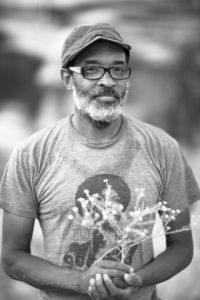
“Well, I’m the son of James Edward Thomas” – “J” “E” “T” “son” – “and I grew up watching The Jetsons as a kid, and I wanted ‘Jetson@gmail.com’ as my email address but it wasn’t available, but ‘Jetsonorama’ was one of the suggestions. I liked the sound of that, sort of an atomic age name, so that became it!” he laughs as he recounts the story, and points out that this might be the only time in history a Google email suggestion has gone on to live in the capacity that “Jetsonorama” has – as an internationally-known and respected street artist and photographer leading a mural movement in the Navajo Nation.
Actually, it’s probably safe to say that is the only time in history that has happened.
Thomas is originally from North Carolina, but came out to “the rez” in Arizona in 1987 as part of a four-year obligation to work in a health shortage area for medical school. He has stayed there ever since.
During his first 18 months in the Navajo Nation, Thomas got interested in photography, specifically in visually documenting the lives of the residents on the reservation. People allowed him nearly unfettered access into their lives, and Thomas’s photos would appear in print media or in gallery shows. But his main interest remained in street art, going back to when “street art” first began to make the pivot away from denigrated graffiti to a legitimized fine art form in New York.
“I was doing a family practice residency in West Virginia not far from New York City and would go there whenever I could,” he remembers. “I would see elements of the hip hop movement, like graffiti on trains, and started checking out the shows of these artists. Then my first trip to Europe I noticed street art everywhere, and anytime I traveled I would go to see the street art.”
In 2009 he went on sabbatical to Brazil. “I saw amazing street art everywhere and there was this amazing sense of dynamism there. I stayed in an apartment above the art studio of a guy whose work I had been seeing all over, and in his studio every day there would be artists from Brazil and all over Europe. They would share their sketchbooks and plan to go out into streets, then gather again in the evenings and talk about their work. There was just a real energy and love that was palpable.”
While in Rio, Thomas saw an installation by JR – a photograph blown up to scale and shown as a medium.
“One frustration of doing shows was that the people whose photographs I was showing weren’t seeing the work,” he says. “I was excited about the possibility of making the images larger and sharing them with people here on the rez.”
After returning to the reservation, Thomas decided to Google the recipe for wheat paste and gave it a shot himself.
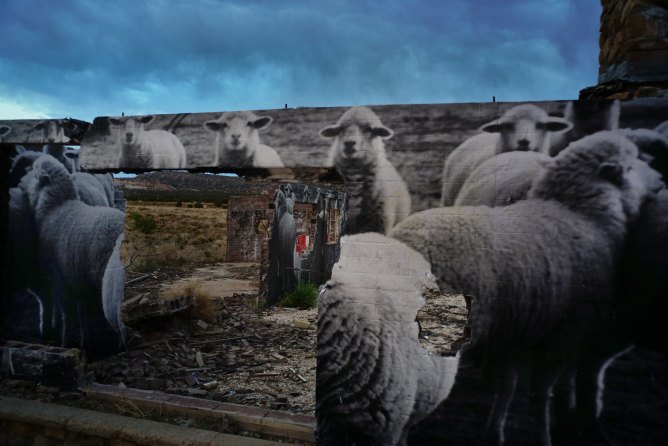
“Initially the project at that point was just me getting up and trying to maintain some of the buzz I had felt while in Brazil,” he says.
His first mixed media mural was installed on a roadside stand that was falling down. A few days later as he drove by he saw people putting it back up – so many people had stopped to photograph the mural that they decided to use the roadside stand again. When he told them that he was the artist behind the mural, they asked him to put one on the other side to catch traffic from the other direction.
This was in 2009. In 2012, the Painted Desert Project had coalesced into a movement, and Thomas started inviting international artists out to work within a 100-mile radius of his home on the rez. Since then, he has worked with artists from all over the United States and Puerto Rico, Mexico, South and Central America, and Europe. A Google map of completed works can be found here.
The Painted Desert Project emerged from work being done in New York City with the Underbelly Project – in which select street artists were invited to abandoned subway stations and over the course of a year created a vast network of underground exhibitions – as well as the Boneyard Project in Tucson, produced by the people at the Pima Air & Space Museum, in which artists were invited to paint decaying war planes left to slowly deteriorate over time. Inspired by these projects, Thomas began inviting artists from around the world for the Painted Desert Project.
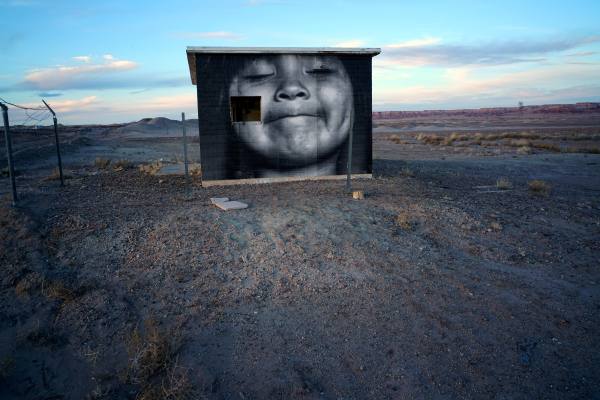
The Painted Desert Project aims to boost tourism on the reservation, to supplement the incomes of families with roadside stands, and to nurture the creative talent of local youth. Through this project Thomas – a member of the decentralized Justseeds Artists’ Collaborative of 30 artists committed to social, environmental, and political engagement – also addresses environmental justice issues that deeply impact the Navajo Nation.
It started with half a dozen artists staying at Thomas’s house the summer of 2012. As more people heard about project, Thomas started to get approached by more artists.
Internationally-renowned Belgian muralist Roa had painted a plane in Tucson and heard about the Painted Desert Project; he came up to participate and donated his work to it. “For people who follow street art, he’s one of the biggest names in it,” Thomas affirms.
“The Painted Desert Project has a great reputation for being a project that attempts to pair artists with people from the community to give them some cultural immersion and relatively free rein to paint whatever they want to paint.”
Jetsonorama doesn’t stay exclusively on the rez; he has been putting up murals in areas outside of the reservation since 2012 and has larger projects planned for October in Durango and Albuquerque.
He would like to do more, he says, but the biggest challenge for him at this point is finding the wall space for new projects.
“I’m at the point of recycling walls now,” he says. “That involves a fair amount of prep; two to three days just scraping off all old paper then maybe painting the background and then we can start the process of pasting. That might involve 75 miles of driving one way so it’s a big commitment.”
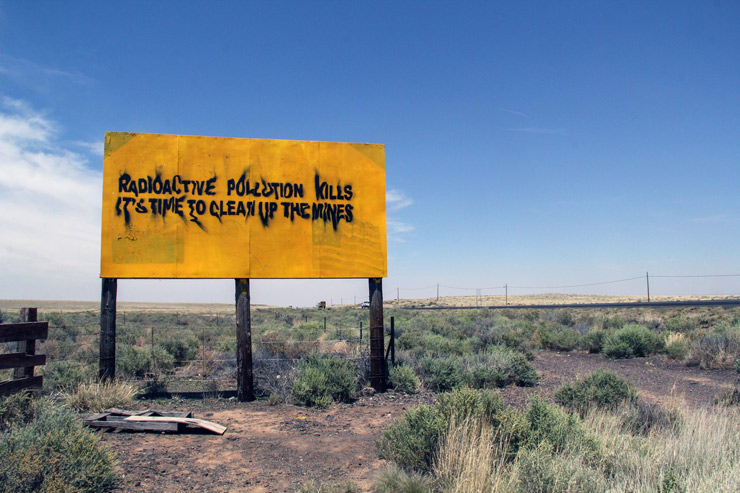
Recently Thomas hosted brothers Icy and Sot, two refugee artists from Iran. During their time in Arizona, they created projects that addressed the uranium contamination on the Navajo Nation, which included stenciled murals on walls and billboards and a film called “No More Yellowcake,” referring to a type of uranium concentrate powder that is the product of uranium mining; there are over 500 abandoned uranium mines on the Navajo Reservation, and the companies that abandoned them were never required to decontaminate them.
Thomas created his own work addressing the subject: Gamma Goat, a continuation of images of sheep that recurred in his installation work in which the subjects this time are colored “gamma ray” green, playing off the friendly cartoon character “Gamma Goat” that was printed in a coloring book distributed to Navajo children to ward them off from accidental contamination.
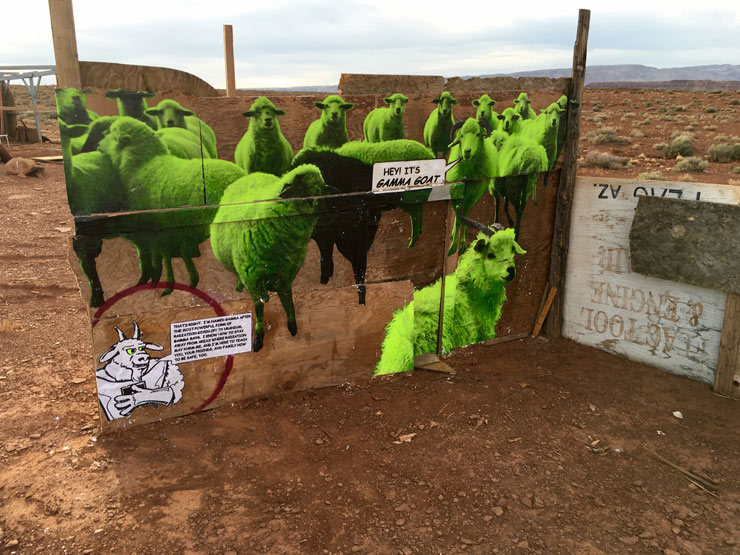
“The Navajo nation has an unemployment rate at about 50 percent,” Thomas writes. “While the tribe is pursuing investment and job opportunities much of the land under consideration for development is contaminated with uranium from over 500 uncapped mines which deters businesses from investing…Meanwhile, contamination continues to affect the land, water, animals and humans.”
The Painted Desert Project might have started out as a way to boost tourism and promote economic vitality, but through this project and its international visibility, Thomas is able to shine a light on serious social and environmental justice issues facing the Navajo Nation that might otherwise continue to be ignored.

(1) How do you like to collaborate?
I love the idea of collaborating and bringing two different styles together and see if there is a point of them complementing each other, but in truth the practice of collaboration is challenging for someone who doesn’t do it on a regular basis.
I feel like [the work I do is] about building community and creating a space to exchange ideas. I live alone and very remotely so having people from all over the world come in and share space with me, I don’t think of that as being a collaboration; I see that as more of an intentional sharing of something that gives you a product in the end. I think of it as more of a residency.
I would just like to collaborate more – with Icy and Sot, these guys are brothers and they work together as a team. The communication between them is effortless; there doesn’t seem to be a clash of egos. They produce beautiful, poignant work. A lot of times I feel like I get stuck and can’t think of anything new or different and would really like other input.
(2) How do you a start a project?
My background is really as a documentary photographer so I have an interest in people and their stories. If I see someone I’m interested in who attracts me in some way, I’ll spend some time photographing them.
(3) How do you talk about your value?
Only to the extent that, for example, there’s a guy in Denver who owns a restaurant [who wants me to do some work for him] and I have to identify some value for the work above and beyond the expenses of travel. I have to be thinking of that to some extent whenever I quote a project or bring artists out to the reservation to create art.
(4) How do you define success?
Success for me is the number of likes I get on Instagram and, damnit, I am not doing well! It seems like my work has resonance; people are moved by it in some way. But in terms of the overall number of people who are digging the work, my numbers are still low. I would define success as people saying to me, ‘Any time my Grandma is driving in the truck and sees picture of your sheep it puts a smile on her face’…when people on the reservation see something and it resonates with them and they feel good about the imagery.
Note: You can follow the Painted Desert Project on Facebook here and on Instagram here.
(5) How is your work funded?
My work [including the Painted Desert Project] is self-funded in that any time I’m paid for a commission or a speaking engagement I use that money to bring artists out here.

[…] She has since recorded several albums, collaborated with several other musicians, appeared in a film narrated Maya Angelou, was the subject of a documentary film, and was even honored in a Mural Arts Program mural commissioned from Chip Thomas – aka Jetsonorama. […]